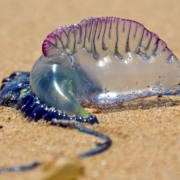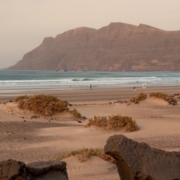Bathing on Lanzarote is almost always safe, but once in a while you may have to take care that you’re not sharing the beach with something that can leave an unwelcome souvenir.
If you’re visiting beaches on the north of Lanzarote, you may come across what looks like brilliant, sapphire-coloured small balloons lying on the sand. The glittering jewel-like effect is even more remarkable on wet, black volcanic beaches such as Janubio and Playa del Paso.
What you’re seeing is often called a jellyfish but is actually a different creature altogether. It is a siphonophore and is actually a colony of many smaller organisms.
The electric blue ones that are often seen in large amounts of Lanzarote beaches are called velella, or By-The-Wind Sailors. They are small, rarely exceeding the size of a credit card, and don’t usually have many tentacles visible. Those washed up by the tide will glisten on the beach for a while before shrivelling up. Any sting they have is mild and cannot usually be felt by a human handling them.
The Portuguese Man o’ War, however, is another matter entirely. This is a larger siphonophore with a more pinkish or purple appearance, a larger “sail” and a greater mass of tentacles. These aren’t so common on Lanzarote, but warnings are still occasionally issued, as their sting can be extremely painful for humans
Researchers at the University of Las Palmas in Gran Canaria are currently using drones and drift boats to monitor the migration patterns of the Portuguese Man o’ War, which may permit more effective ways of predicting their arrival on Canarian beaches.
Another stinging thing that you probably won’t ever encounter on a Lanzarote beach is the blue dragon, A beautiful species of sea slug that normally lives far out to sea. This animal feeds on the Portuguese Man o’ War, storing its stinging cells to use itself.
This means that the sting of the Blue Dragon can be even more concentrated than that of the Portuguese Man o’ War. Fortunately, the Blue Dragon rarely reaches the shore, and the closure of two beaches after specimens were found in Tenerife last year is the only recent sighting of this creature.
The fact is that you are very unlikely to get stung by a jellyfish in Lanzarote’s seas, but if you do, the culprit is likely to be a Mauve Stinger (Pelagia noctiluca).
This is a smallish purple jellyfish that occasionally arrives in local waters in large numbers. As it lives below the surface of the sea, it can only be seen by bathers wearing goggles, and even then, it’s not easy to avoid the jellyfish.
Victims of the Mauve Stinger include UK’’s ex-Prime Minister David Cameron, who was zapped by a jellyfish at Playa Garita in Arrieta ten years ago. The Editor of the Gazette has also swum into one and confirms that, as well as being “bloody painful”, the sting can cause scarring.
JELLY CAUTION
Local ocean currents and winds mean that jellyfish and siphonophores are more likely to be found on northern beaches rather than the sheltered southern resorts. Sometimes they make their way round to the south, but there will often be reports of jellyfish on beaches such as La Garita and Costa Teguise first.
If jellyfish are spotted, lifeguarded beaches will put up a yellow or red flag, accompanied by a special flag with jellyfish on it. In extreme cases beaches may be closed off. This, however, is very rare.
If you are stung by a jellyfish, don’t pee on it. The official advice is to wash the area with sea water to remove any tentacles that may remain, then seek medical attention.











Leave a Reply
Want to join the discussion?Feel free to contribute!